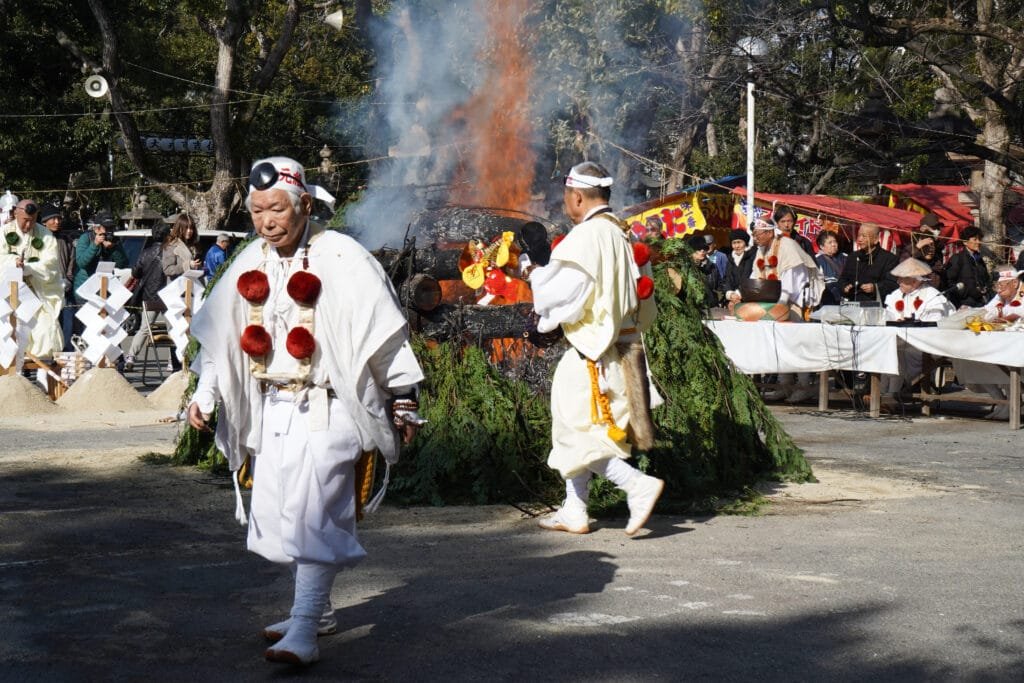
In Japan, it is custom for people to take part in Hatsumode, the first shrine visit of the New year. Between January 1st and 3rd, people visit to pay their respects and wish for a healthy year ahead. However, at Sumiyoshi Taisha, a sequence of festivals take place throughout January to celebrate the turn of the year. New Year Osaka
Table of Contents
Wakamizu – January 1st 5am-6am

Genshisai – January 3rd 8am
The emperor of Japan presides over the Three Palace Sancturies, Kashikodokoro, Koreiden and Temple. It is a ceremony to celebrate the beginning of the throne. This festival began in 1970 on January 3rd, when eight gods and the successive emperors were enshrined in the eight temples of the Shinto shrine. Nationwide, people pray for the prosperity and health of the country.
Toka Shinto ritual – January 4th 1pm
This event is to invite the god of good fortune by stepping on the earth at the beginning of each year. The spirits of the land calm and the evil dissapears. A dancer holds a young plum branch over a crown and steps on the earth to pray for god’s blessing and to banish evil. A small rice cake and fruit are also offered as a prayer. In detail, it is also called “Ararebasiri Shinto ritual” or “Oberobero Festival”.
Moreover, people dance to the Uzue no Mai and Ougi no Mai songs, and to the beat of the drums. Hearing the tone of this drum, each worshiper wishes for the fertility of the year.
Hakuba Shinto ritual – January 7th 11am
This is a traditional event derived from the “Hakuba Festival”. People pulled Hakuba out in the garden of the Imperial Palace during the Heian period. There is a white-haired horse, called “Aouma”, which you can see. When you see it at the beginning of the year, the year will be disease-free and very auspicious. What’s more is, specifically on January 7th, you can receive a special red stamp and amulet (Mamoru Takekoma) that are only on the day of the Hakuba Shinto ritual.

Ichiebisu daikokusha – January 9th and 10th
Two dieties, Kotoshironushi and Okuninushi (Okuninushi no Mikoto), are responsible for prosperity of businesses. They are enshrined in Ichiebisu daikokusha and the festival is the oldest Ebisu festival in Osaka. Various Events such as praying for business prosperity and disease-free by “sowing fortune mochi” and burning a prayer tree with a wish written on it, take place.
Wakamiya Hachimangu Festival – January 12th 11am
Four cauldrons are set up in front of the shrine at the festival of Setsumatsusha Wakamiya Hachimangu, located on the south side of grounds. It is a shrine that enshrines Emperor Ojin (Hachiman God), the son of Empress Jingu, the deity of the 4th main shrine.
A shrine maiden holding bamboo grass in both hands, matches the whistle and drums of Naniwa Kagura “Yutate Kagura”. The elegant theatre of the maiden sprinkling the hot water is a must see. Another key point is that this Shinto ritual is a pray for a good harvest of five grains rice, the adzuki bean, the soybean, barley, and wheat.
Shinto ritual – January 13th 10am
This is a Shinto ritual that prays for the blessing of exorcism with an arrow dedicated to the shrine. Following this festival, the master archer aims to hit the mark. Furthermore, at the beginning of the year, the aim is the dispelling evil spirits that bring evil to agriculture. It is a service held by volunteers of the Osaka Prefectural Kyudo Federation.
New Year dedication festival – January 15th 10am
Held three times a year, on January 15th, the first dedication festival takes place. After the congratulatory words and kagura, the priest will read the waka poems in a traditional manner. In addition, people refer to Sumiyoshi Taisha as the “god of waka poetry”.
Old bill burning ceremony – January 15th 9am
Following the turn of the yeat, the previous years wishes, lucky charms and amulets are burnt in a large bonfire. In addition, priests read out a special prayer whilst the fire takes place. If you take the smoke off this fire, you will be free from illness for the coming year.

Watch Osaka’s New year celebrations here
Where to Enjoy New Year’s in Osaka
All the events listed above take place at Sumiyoshi Taisha Shrine.
Address: 2-9-89 Sumiyoshi, Sumiyoshi-ku, Osaka 558-0045
Phone: 06-6672-0753
Website: http://www.sumiyoshitaisha.net/
Final
New Year’s celebrations are one of the most important times in the calendar year in Japan. Traditionally, people will visit a local shrine and take part in hatsumode. You can find food stalls and various events going on so it’s a fantastic way to experience Japanese culture. Lastly, in Osaka, the sequence of small festivals is a special way to celebrate the turn of the year like no other.






















